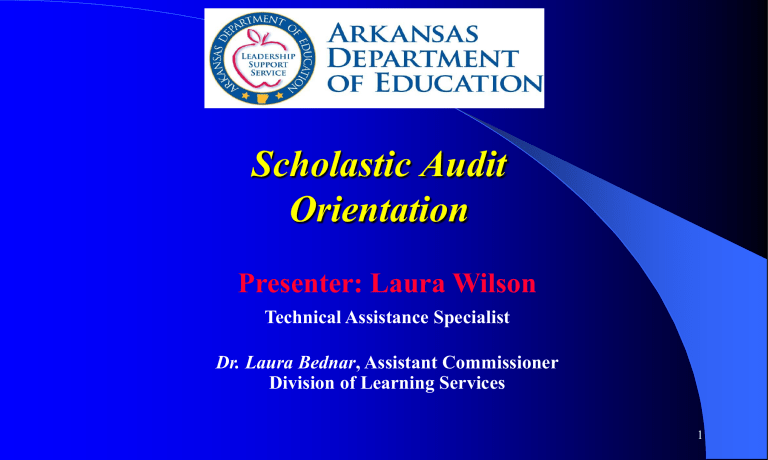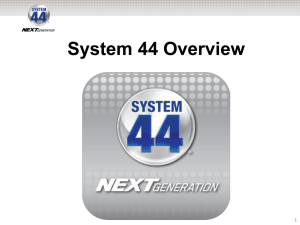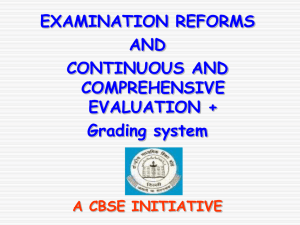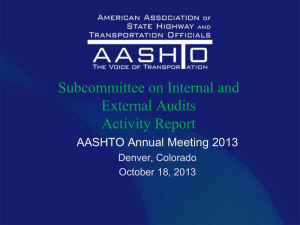Scholastic Audit Orientation - Arkansas Department of Education

Scholastic Audit
Orientation
Presenter: Laura Wilson
Technical Assistance Specialist
Dr. Laura Bednar, Assistant Commissioner
Division of Learning Services
1
Arkansas Department of Education (ADE)
Scholastic Audit
The Scholastic Audit is a comprehensive review of a school
’ s learning environment, efficiency, and academic performance. The purposes of the audit are to analyze strengths and limitations of the school
’ s instructional and organizational effectiveness and to make specific recommendations to improve teaching and learning.
2
Standards and Indicators for School
Improvement (SISI)
The School Level Performance Descriptors for Arkansas
’
Standards and Indicators for School Improvement is for team members to use in determining how effective the school has been in organizing its work around the nine standards. Below each standard are indicators that show the degree to which the standard is in place. Team members will determine the performance levels observed under each indicator of the nine standards.
This tool can be found on the ADE web site.
3
Academic Performance
Standard 1: Curriculum -The school develops and implements a curriculum that is rigorous, intentional, and aligned to state and local standards.
Standard 2: Assessment -The school utilizes multiple evaluation and assessment strategies to continuously monitor and modify instruction to meet student needs and support proficient student work.
Standard 3: Instruction -The school’s instructional program actively engages all students by using effective, varied, and research-based practices to improve student academic performance.
4
Learning Environment
Standard 4: School Culture -The school/district functions as an effective learning community and supports a climate conducive to performance excellence.
Standard 5: Student, Family, and Community Support -The school/district works with families and community groups to remove barriers to learning in an effort to meet the intellectual, social, career, and developmental needs of students.
Standard 6: Professional Growth, Development, and Evaluation -The school/district provides research-based, results driven professional development opportunities for staff and implements performance evaluation procedures in order to improve teaching and learning.
5
Efficiency
Standard 7: Leadership -School/district instructional decisions focus on support for teaching and learning, organizational direction, high performance expectations, creating a learning culture, and developing leadership capacity.
Standard 8: Organizational Structure and Resources -The organization of the school/district maximizes use of time, all available space and other resources to maximize teaching and learning and support high student and staff performances.
Standard 9: Comprehensive and Effective Planning -The school/district develops, implements, and evaluates a comprehensive school improvement plan that communicates a clear purpose, direction, and action plan focused on teaching and learning.
6
7
8
9
2010-2011
ADE Scholastic Audit
1. Identification of schools in School Improvement. . . . . . . . . ADE
* ACTAAP/Act 949 ~ Year 3, 4, 5, and beyond
* Special Request
* Smart Accountability
2. Notification of Scholastic Audit on-site visit. . . . . . . . . . . . . ADE
3. Requests for School Portfolio. . . . . . . . . . . . . . . . . . . . . . . . . ADE
10
4. On-Site Scholastic Audit. . . . . . . . . . . . . . . . . . . Scholastic Audit Team
5. Oral Summary Report of Findings. . . . . . . . . . . . . . . . . . Team Leader
6. Scholastic Audit Report Reviewed/Finalized. . . . . . . . . . . . . . . . . . . . . .
. . . . . . . . . . . . . . . . . . . . . . . . . . . . . . . . . . . . . . . . . Scholastic Audit
—
ADE
7. Report of Findings to Superintendent/School. . . . . . . . . . . . . . . . . . . . .
. . . . . . . . . . . . . . . . . . . . . . . . . . . . . . . . . . . . . . . . .Scholastic Audit
—
ADE
8. Final Report. . . . . . . . . . . . . . . . . . . . . . .Division of Learning Services
* Coordinator of School Improvement
* School Improvement Supervisor
11
9. Schedule On-Site Visit. . . . . . . . . . . . . . . . . . . . . . . . . . . . . . . . . . . . . . . .
. . . . . . . . . . . . . . . . . . . . . . . . . . . . . School Improvement Supervisor
10.On-Site Visit. . . . . . . . . . . . . . . . . . . . . . . . . . . . . . ACSIP Committee
* Revise ACSIP
* Incorporate Recommendations
* Identify Resources Needed to Support the
Implementation of the Revised ACSIP
* Implementation of the Revised ACSIP
12
Scholastic Audit Visit
Before the Visit:
Portfolio Contents
The school/district portfolio should be made available for the team
’ s review prior to the school visit. The entire team will come together the afternoon or the evening prior to the visit for the purpose of reviewing school/district data.
13
School Portfolio Contents
Arkansas Comprehensive
School Improvement Plan
(ACSIP) ~ School & District
Curriculum Alignment
Documents
District Evaluation Plan
District Technology Inventory
Teacher Lesson Plans
Master Schedule
Professional Development
Activities
Local School Board Policies
14
School Portfolio Contents Continued
School Handbooks Student Achievement Data
School Report Card
(including expanded version)
School Survey Data
State Assessment Results
Student Work Samples and
Writing Portfolio Analysis
Data
Samples of Student
Assessments
15
16
Stakeholder Perception Surveys
The results of these surveys will assist a team in determining stakeholder perceptions regarding the school as a learning organization. The surveys are designed for random completion by parents, teachers, staff, administrators, students, and community members.
17
Stakeholder Perception Surveys Continued
Categorized into Academic Performance,
Learning Environment and Efficiency, they rank descriptors from
“ strongly agree
” to
“ no opinion.
”
Step-by-step directions for completing the surveys will be provided.
18
Monday 7:30 a.m.
8:10 a.m.
8:45 a.m.
11:15 a.m.
11: 40 a.m.
2:00 p.m.
3:00 p.m.
3:45 p.m.
5:00 p.m.
6:30 p.m.
7:30 p.m.
Sample Team Schedule
Arrive at school
Preliminary interview with principal
Observations and interviews
Debriefing and status check
Observations and interviews
Interview with Principal
Interviews with parents
Interviews with school board members
Team meeting for generating questions and expressing concerns
Dinner
Individual or team work on evidence and standards
19
During the Visit
Classroom Observations
Classroom observations are conducted during the morning and afternoon. During classroom observations, team members will record specific examples of instructional activities noting those that appear to be of high quality.
20
During the Visit Continued
Team members are responsible for documenting and sharing with the team detailed information about:
Teaching practices
Student participation
Student work
Administrative support
21
Interviews
Team members will interview nine role groups at the school site/district site:
Principals
Counselors
Teachers
Classified staff
Students
Parents
Superintendent/designee
Central office staff
School board members
22
Debriefing with the Team:
After DAY ONE of the Audit / Review
23
Purposes of the First Team Debriefing . . .
… to share preliminary concerns determined through first interviews and observations;
… to request assistance from team members in determining accuracy of these preliminary concerns;
… to “brainstorm” possible avenues of inquiry for the evening’s work in revisiting the school portfolio, and
… to hypothesize findings for assigned standards.
24
EXAMPLES of team member statements during debriefing:
Standard 1:
“I observed four different classrooms, today, and did not see a posted curriculum for student review. Did anyone see something different?”
Standard 2: “Three different students told me that they know their work is good when the teacher gives them a grade. They were unfamiliar with scoring guides and rubrics. When you all interview students tomorrow, could you emphasize this with them so that I can see if it is a school wide issue?”
25
EXAMPLES of team member statements during debriefing (continued):
Standard 3:
“Has anyone seen a real primary class, yet?”
Standard 4: “I happened to be near the main entrance when some parents came in. They all agreed to a quick interview about their perception of school culture. They each believed their children are safe in the school and that the principal works hard to make the school orderly and productive. However, they said some teachers treat children with well-to-do families a lot better. Help me get to the bottom of this over the next couple of days.”
26
EXAMPLES of team member statements during debriefing (continued):
Standard 5:
“Kids, teachers, and administrators all seem to love their counselor. Can you tell if barriers to learning are truly addressed?”
Standard 6:
“Staff members don’t seem to use the PD that they learned about this summer. They attended two full days on differentiation and one on inclusion, but I didn’t see anyone implementing either practice. Could you help me check for this?”
27
EXAMPLES of team member statements during debriefing (continued):
Standard 7:
“The principal is very nice and seems to have great rapport with students and parents. Has anyone heard or seen anything different?”
Standard 8: “Well, I can’t find any updated school board policies, a budget, or minutes? Has anyone located these?”
Standard 9: “Their school improvement plan probably resembles their board minutes and curriculum– very little written or implemented and nothing evaluated for impact. Let’s all look.”
28
Exiting the School
The chairperson will present an oral summary report at the time agreed upon with the principal.
The chairperson should thank the team for its hard work and the school for its hospitality.
The chairperson should highlight the outstanding practices that the team observed.
29
Exiting the School Continued
The chairperson will summarize recommended
“Next Steps.”
The chairperson will communicate to the school that they will receive a copy of the written report in four weeks.
30
Scholastic Audit Report
Findings for each of the 88 indicators
3 to 5 recommendations for each of the nine standards
Next Steps
The school will prioritize the recommendations.
The School Improvement Supervisor will assist the school in including the recommendations in the ACSIP.
31
Scholastic Audit
Ms. Estelle Matthis
Office of Scholastic Audit
501-683-5780
Dr. Laura Bednar, Assistant Commissioner
Division of Learning Services
32








